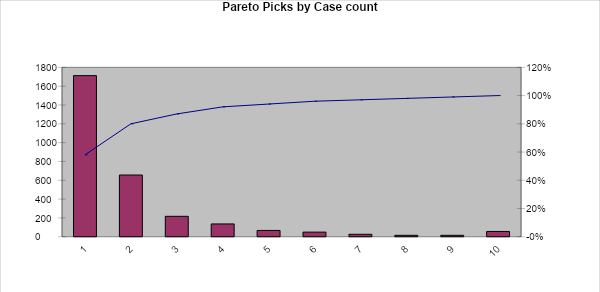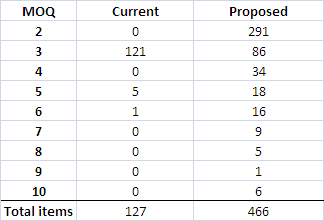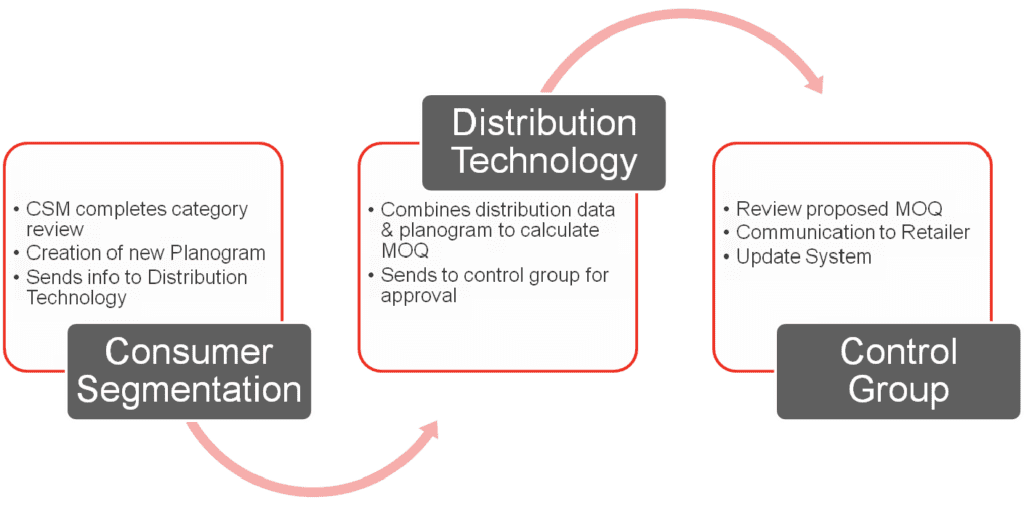Download White Paper: Improving Store and DC Productivity through Minimum Order Quantity Analysis
Background
A Value Stream Assessment (See White Paper: Finding Productivity Improvements from Field to Table) at this Grocery Retailer & Distributor identified poor productivity in its distribution centers during order selection and in its retail stores during shelf restocking. A very high percentage of the items selected (picked) in the distribution centers and re-stocked in the stores were in quantities of 1 case.
This company’s roots were as a high volume, limited assortment retailer and distributor. Over time the business had shifted allowing the stores to reorder a higher mix of items at lower volumes. Given the companies market position as a low-price leader, this reduced profit margins.
The two root causes of this shift were identified as:
- Stock-keeping-unit (SKU) count growth outpacing sales growth, and
- Allowing minimum order quantities from the stores to the distribution centers to drop to a quantity of one
This white paper will study how this company quantified the impact of allowing its stores to order in one case quantity and then recalculated minimum order quantities for higher volume items. (For details of how SKUs were reduced see White Paper “SKU Reduction – Biggest SKLUsers”)
A Supply Velocity Consultant led a team of employees through this 5 week project. The Supply Velocity consultant facilitated, but the employees did most of the analysis and therefore owned the improvements.
Project Outline
- Evaluated all SKUs and the case quantity they are most frequently ordered at, to establish baseline data for how stores are ordering
- Time studied retail store shelf restocking and distribution center order selection labor to determine the negative labor productivity impact of the current ordering policy
- Graphed the results in a trend chart
- Determined that the greatest labor productivity improvement happens when the order quantity increases from just 1 to 2 cases
- Recalculated minimum order quantity for all items using Multi-Variable Pareto analysis based on:
- Item unit movement
- Pack-out (number of units that fit on the shelf space allocated in stores)
- Shelf life
- About 20% of all SKUs had a re-calculated minimum order quantity greater than 1 case
- The most conservative methods were used to ensure this project didn’t just push inventory out to stores, resulting in shrink (throwing away items that go beyond their shelf-life limit or are damaged)
- Communicated all items on the minimum order quantity to all stores through a comprehensive communication plan
- Communication plan included data to show stores how increasing minimum order quantity on select items would improve their labor productivity
- Created a control plan to ensure new items, SKU reduction and sales history will be used to update the minimum order quantity on a twice yearly basis
Time Study Analysis
To quantify the problem, we time studied order selection in the distribution centers and shelf restocking in retail stores. We conducted a few snapshot analyses of different distribution centers to understand the current state of “order quantities”. The graph below shows that out of the approximately 2800 items, a majority are ordered in quantities of 1 case. The time study data also showed that the second case selected or stocked is essentially “free” and the same movement is used for two cases as for one case.
At the outset of this project the team was worried that any increase in minimum order quantity would be viewed by store managers as an attempt to push inventory out from the distribution centers to the stores. This data showed that increasing minimum order quantity from one case to just two, gave us the greatest percentage of labor productivity improvement.
However, we didn’t just want to increase all items to a 2 case minimum order quantity. Instead, a statistical tool, Multi-Variable Pareto was used to calculate the proper minimum order quantity based on a mix of inputs.
Distribution Center Order Selection Quantity (# of items picked per quantity)
57% of the items in distribution centers were selected at a 1 case quantity
“Time to Select per Case Quantity” in the Distribution Centers – Based on case count per selection
When selecting 2 cases of an item, the time per case drops by 45% from 1 case.
Time to Re-Stock SKUs on Shelves in Stores – Based on case count
When restocking 2 cases of an item, the time per case drops by 61% from 1 case. This shows that the greatest productivity improvement occurs when going from 1 to 2 cases, which is easier to “sell” to the stores than making large increases in minimum order quantity. They can reduce labor by 37 seconds per case by ordering and stocking 2 cases of an item versus 1.
Multi Variable Pareto Analysis
- Recalculated minimum order quantity for all items using Multi-Variable Pareto analysis based on:
- Item unit movement
- Pack-out (number of units that fit on the shelf space allocated in stores)
- Shelf life
- About 20% of all SKUs had a re-calculated minimum order quantity greater than 1 case
- The most conservative methods were used to ensure this project didn’t just push inventory out to stores, resulting in shrink
Multi-Variable Pareto is a method that uses more than one “measure” to sort SKUs from highest to lowest performing. Normal Pareto Analysis has been used to develop guidelines such as the 80/20 rule (20% of customers generate 80% of sales). When using multiple variables, there has to be a way to normalize the data so all variables are part of the analysis.
We used three variables to determine the correct minimum order quantity for an item.
- Cases sold per week on average for each item
- The number of cases that fit in the given shelf space
- Product shelf-life
Each of these variables are positively correlated to Minimum Order Quantity.
- The higher the cases sold equals higher Order Quantity
- The greater the shelf space (pack-out) equals higher Order Quantity
- The longer the item’s shelf-life equals higher Order Quantity
The team of subject matter experts used retail experience to determine each of these factors and their impact on minimum order quantity. Results of this analysis are shown below.
The calculation was very conservative, as the results have shown. Only 466 of 2800 items have a minimum order quantity greater than 1 case. This was largely driven by two factors. Item shelf-life limited our ability to make any shelf-life sensitive item greater than 1 case. Our calculation took this limiting factor into account, to ensure we weren’t causing shrink (throwing away items that go beyond their shelf-life limit or are damaged) at the stores.
In addition, lower case movement drove many items to a 1 case minimum, even if they didn’t have shelf life limitations. The lower case movement is due to SKU proliferation and was addressed by the SKU Reduction (Biggest SKLUsers) project.
Results of Minimum Order Quantity Calculation
Communication & Control Plan
- Communicated with all retail stores about how the minimum order quantity analysis was conducted and the resulting new plan
- Communication plan included data to show stores that increasing minimum order quantity on select items would improve their labor productivity
- Created a control plan so new items, SKU reduction and sales history will update the minimum order quantity on a twice yearly basis
It was critical that this project was presented as a positive for our retail store-customers. We created a communication plan that showed two key aspects of this change:
- The conservative nature of the change
- only 466 of 2800 items are receiving a minimum order quantity increase
- This change is good for the stores and will improve their labor productivity
To ensure that this process endures and does not get reversed over time we included a control plan. This is shown in the graphic below. As Category Marketing Managers evaluate items, adding and reducing SKUs, changes will be reflected in new pack-out quantities. This quantity will get fed to Distribution Technology who will recalculate this items’ minimum order quantity using the same Multi-Variable Pareto calculation. A control group, made up of Merchandising, Distribution and Retail Directors will review the list, make changes in the ordering system and communicate changes to store customers.
Results
By taking the higher sales volume SKUs and increasing the store minimum order quantity, we decreased the time per case to stock shelves in the stores and select items in the distribution centers.
Using only the 1 to 2 case increase in minimum order quantity for the 466 SKUs reduced the labor time per case resulting in a labor savings of $1.2 million.
The expectation for this process is to slowly grow the number items with a minimum order quantity greater than 1 case beyond 20%. By rationalizing and reducing SKUs we should increase the shelf pack-out of remaining items, thereby increasing the minimum order quantity.
"*" indicates required fields
“Anheuser-Busch Precision Printing had been implementing Lean Operations on our own for the past two years. We needed to move faster and partnered with Supply Velocity, Inc. Through Supply Velocity, Inc.’s mathematical workflow balancing and visual management tools, dramatic improvements were achieved. The entire converting operation was rearranged based on Lean principles. The result is a 20.6% productivity improvement, enabling us to operate with 23 fewer people in production.”
“I am thrilled to provide this testimonial for Supply Velocity and their outstanding work in implementing Lean Warehouses and processes at Crescent Parts & Equipment through the COVID pandemic. With their data-first focus and Mitch’s exceptional coaching and experience, they transformed our business into a more supply chain-oriented organization, enabling us to grow while prioritizing employee safety and creating a better work environment. Supply Velocity’s expertise in Lean methodologies and their comprehensive evaluation of our customers have been instrumental in optimizing our operations and increasing customer satisfaction. We highly recommend Supply Velocity to any company seeking to implement Lean processes and enhance their supply chain efficiency.”
“The role of the Erie Insurance Marketing Department has been evolving over the past several years – from a support role to a more critical role of driving growth in our organization. Because of our increased workload and desire to prioritize the most critical projects, we hired Supply Velocity to teach us the skills of Lean Six Sigma.Participants included the Promotions, Market Research and Agency Licensing sections of the Marketing Department.
We learned valuable tools to help us to prioritize based on the voice of the customer.
I firmly believe these skills made a difference in how we work every day. We are moving new projects forward, eliminating or changing ineffective processes, and we are a much stronger department. We continue to use the tools to help us with our highly-complex and time-consuming projects. Supply Velocity helped us to accomplish our goals.”
“Myerson engaged Supply Velocity, specifically Ray Davis to visit our plant in Trinidad to conduct a two day assessment of our production procedures and provide us feedback on areas for improvement and where applicable, areas for future analysis.Put simply, we got everything we paid for and in addition to more in depth analysis, we got specific tasks that were immediately actionable. Our local management team found Ray to be engaging, highly credible and insightful based on his wide experience. In other words the cultural differences and lack of specific industry knowledge weren’t impediments to things we could implement immediately and on our own. In a nutshell it was money well spent and will pay itself back many times over.”
“Your process encourages this group to work together, better communicate and have fun doing it.”
“In thirty years of hiring consultants, Supply Velocity, Inc. was the first to tell me what they were going to do, set a price they stuck to and substantially exceed my expectations. I have recommended them to friends and acquaintances. They were true partners in assisting with the turnaround of an acquisition we had been struggling with for two years.Their math-based technology, solid down-to-earth facilitation skills, and positive, patient and enthusiastic attitude combined to make our implementation of Lean a very rewarding experience.
We increased our production by 50% in the first month of implementation and continue to see improvements. Improvements have not only been realized in productivity, but also in quality and morale. We have increased profitability by $2M on flat sales of $10M.
Based on Supply Velocity, Inc.’s integrity and our results, I will continue to refer them to others and utilize them in the future as we expand our company through acquisitions.”
“For several years we have worked with Supply Velocity to support us with their expertise on Lean Operations and Supply Chain Management. Supply Velocity has helped us implement Lean, improve our inventory systems, and educate our people. They are professionals who are always available to help us as needed.”
“Our experience with Supply Velocity was one of the best values we have ever had from a consulting project. Cyril Narishkin brought a structured lean methodology, invaluable experience and engaging facilitation skills to help us streamline a very complex and disjointed sales order process. Just as importantly, our team now has the knowledge and process competencies to address other business improvement opportunities going forward.”
“Supply Velocity’s Lean Six Sigma System has given us new tools to help improve our sales performance. We have learned new ways to analyze our business which makes problem solving more accurate and has made us better leaders.”
“Many thanks to all three Supply Velocity presenters. I think you guys took a very difficult time for learning and capitalized on everyone’s time and training needs. I truly hope this helps your business as this was a considerable undertaking on the part of Supply Velocity. Outstanding!!”
“We engaged with Supply Velocity to help us embed process improvement at all levels of the business. Our team learned from Mitch to let the data drive decisions, to use Lean tools to help us see our processes critically and objectively, and to create a control plan to manage all of the tasks that were the outcome of the data study.The project turned out to be very significant to the company and most importantly, our customers. We reduced our customer wait times by 40%, and cut in half the labor cost to fulfill customer orders.
Some results are not able to be measured. However, as a result of this project, we have started to build a Lean mindset and culture, which is part of our strategic mission to save our customers money. Supply Velocity has been a valued partner in this mission.”
“Closure Medical recently completed a major reorganization in order to enhance our ability to rapidly create innovative medical devices. We hired Supply Velocity to help us map out the process and service flows of the new organization that would maximize our product development process (PDP). In four weeks, Supply Velocity helped us envision a new PDP structure, develop measures and accountability for each step, and gain consensus within the organization. Supply Velocity’s focus on speed and accountability helped us complete a critical project in a timely fashion.”
“We are pleased that Essex selected Supply Velocity, Inc. as our Lean Implementation Partner. At one facility, we have saved over $350,000 in work-in-process inventory, reduced throughput time from 2 weeks to minutes and increased inventory turns 3 to 8 times per year. All these results are in just 6 months. Our return of investment is very high.”
“Supply Velocity created visibility within our Assurance Services Group… visibility of performance, Client-service, employee satisfaction and processing time. Using the Supply Velocity System, Audit Report Cycle time is down over 50%. We are using his strategies to create greater Client loyalty.”
“Mitch Millstein and his team helped guide our shop fabrication division in the re-layout of our custom pipe and steel fabrication facility when we moved into a new building. It is not only the results but how he helped. We were involved in every step. I personally did time studies and was able to see the non-value added steps required to manufacture in our old layout. When we created our new layout, everyone was involved, from the executive team to our direct labor force. With Mitch’s help we increased our throughput by a 3x multiple, while providing more competitive prices to our clients as a result of the efficiency improvements.This has enabled us to not only make more money but also to expand our commercial reach and serve more, and larger customers. I would recommend Supply Velocity to any company that wants to make improvement in supply chain and operations.”
“C&R was struggling with labor productivity. The construction crews were often missing materials that they needed to do their work. This caused significant idle time. Supply Velocity, Inc. and C&R used value stream mapping and visual management tools to make dramatic improvements in operations. Most importantly, two years later C&R is sustaining and improving on the implementation. C&R’s return on investment was 11:1. C&R had a record year last year in both sales and profits and would not have been able to pull it off without the changes Supply Velocity, Inc. helped us make.”
“Isolating a problem, finding short, and long term solutions with measurable results is what was promised and results is what was delivered by Supply Velocity. Upon launch of the Lean Six Sigma Selling System, we knew more about our customers, our products, and were able to create a solid plan to increase sales of our most profitable products. Within months of implementation, our booked sales jumped 60% and our most valued customers were getting direct, active, and calculable attention.”
“Supply Velocity has provided the technical expertise and political capital to move our project forward. They have just the right amount of push and the right amount of support. Supply Velocity has helped us make real changes to improve efficiencies in logistics without jeopardizing our performance. We’re happy and our customers are happy.”
“In the spring of 2003, the St. Louis Area Chapter of the American Red Cross engaged Supply Velocity, Inc. to perform a study and make recommendations to streamline office processes, maximize cash flow in purchasing and warehousing and restructure and enhance our maintenance department. Supply Velocity, Inc.’s process was methodical, flexible, staff-oriented, inclusive and, above all, trackable.In the last six months, our Chapter has realized expense savings of over $380,000 annually, and significant improvement in intra-company service levels has been attained. Supply Velocity, Inc. will return to the Chapter periodically throughout the next 18 months to audit our newly implemented processes. We have been pleased with our results and Supply Velocity, Inc.’s professionalism.”
“Supply Velocity has helped Clean succeed in a number of ways. First, they provided the education that kicked off our Lean Process Improvement journey. They also facilitated a number of large supply chain and process improvement projects including: 1) building quality into our direct-labor productivity incentive program, 2) designing the layout of our garment warehouse, and 3) streamlining our route service process.We have integrated the methods that Supply Velocity taught us into our management and strategic planning. In the process our quality measurement has improved 22% from 2013 to 2015, we have reduced required annual labor by 2200 hours from the garment facility layout project and we’ve seen 50% decrease in error rate. Obviously the numbers speak for themselves, but just as important, Supply Velocity has been fun to work and have become true partners. They have “taught us how to fish” so our internal teams are able to implement change on their own, with the skills we learned from Supply Velocity. This relationship has been invaluable.”
“Supply Velocity gave us the tools to analyze our business and processes based on the facts and numbers versus our perceptions. Our common quote was “Let the numbers lead us”. The key for our organization was how quickly we moved from classroom to actual project initiation. We were able to jump in, start using the tools and see a difference right away.
The get-into-action approach was good for our culture.”
“In 2015 we began working with Dr. Mitch Millstein to optimize our inventory locations supporting e-commerce and in-store inventory needs. From this work we developed a new omni-channel warehousing and inventory plan that entirely redefined our approach to warehousing, inventory management, store distribution and fulfillment. As a result of the analyses by Dr. Millstein we have begun the move to an improved omni-channel design by reassigning MSAs to new warehouses, greater leveraging of in-store inventories to satisfy e-commerce demands, and exploring acquisitions of new warehousing space in strategic locations. We have already seen an improvement of $300,000 from both more efficient shipping strategies due to better inventory management.”
“In a time of volatile supply chain disruption, Supply Velocity is helping us develop Demand and Supply Planning processes to proactively tackle these new challenges. They are genuine partners, working with our team, facilitating and teaching.”
“We used Supply Velocity to rethink our sales process. By analyzing the entire process we found wasted time in our Sales, Admin and Operations departments. Streamlining this process created extra time for each Sales Rep, allowing them to spend more time with Customers and increase the value we add. Gross profit margins are up 40%!We are now using Supply Velocity to help us rethink our entire Strategic Plan.”
“We used Supply Velocity on our Warehouse optimization project. One of the key characteristics of Supply Velocity is that they listened to our requirements and provided a clear path for our Warehouse processes using lean tools and our future sales growth as objectives.”
“Supply Velocity is driving instrumental change in our inventory management processes. This is critical for us to be competitive in a supply chain environment with numerous disruptions. They are making change happen, which can be challenging in a 182 year old organization.”
“We are using Supply Velocity’s Lean Six Sigma methods to analyze a variety of processes including rationalizing SKUs (stock-keeping-units). By using math to evaluate SKUs we took some of the emotion out of our decisions. We expect significant increases in sales and productivity from reducing poor performing SKUs.”





